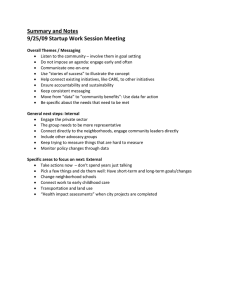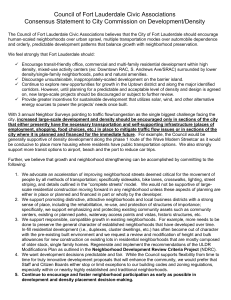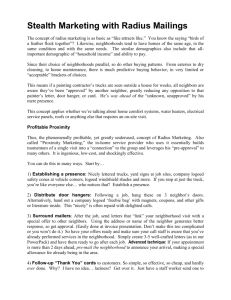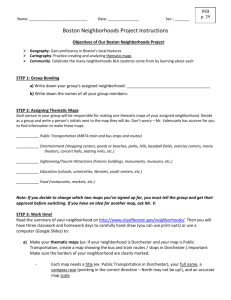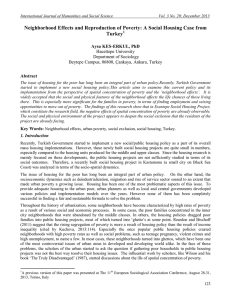Neighborhood Preservation and Volunteerism
advertisement
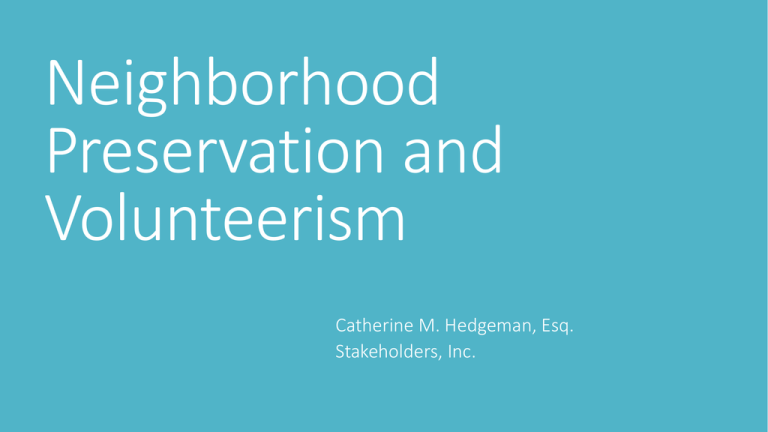
Neighborhood Preservation and Volunteerism Catherine M. Hedgeman, Esq. Stakeholders, Inc. The Vision Well-tended public spaces create a better quality of life that attracts tax-paying businesses and residents to communities. Experts consider such spaces to be essential to creating sustainable communities. Run-down, litter-strewn spaces, however, signal lawlessness and lack of community spirit that can lead to crime and other negative behaviors. Engaged communities are far less likely to let their neighborhoods fall into poor conditions and can act as a powerful force in preventing crime. The Plan Develop a neighborhood plan with Key Stakeholders Build the neighborhoods capacity to carry out the plan Execution of the Plan Track and Report the Impact Metrics Develop a neighborhood plan with Key Stakeholders Engage residents, neighborhood associations, land banks, businesses, faithbased organizations to volunteer to come together and identify neighborhood challenges and opportunities. Develop a neighborhood vision statement and a mission statement for the neighborhood plan committee Develop an execution plan and plug in the resources needed to execute Develop a system for tracking and reporting impact Possible volunteer opportunities include: Committee co-chairs/steering committee, notes/minute takers, discussion facilitators, skills-based volunteer opportunities (marketing, community outreach, web/social media services) Build the neighborhoods capacity to carry out the plan Develop the capacity of residents as leaders to drive community change and remove barriers to revitalization efforts through: Volunteer Management training programs offered by local resources Development of Volunteer job descriptions and recruitment of volunteers to assist with execution of the plan Providing networking opportunities and introductions for resident leaders to community partners Developing a resource catalog outlining skills, services and tangible items available to convert neighborhoods into places for opportunity. Execution of the Plan Assign tasks to volunteers/volunteer teams Establish a timeline for completion of tasks Schedule regular progress report meetings Track and Report the Impact Metrics A Process for tracking and reporting impact must be developed in the planning stages. Consider how you will measure progress through a system of outputs and outcomes Example Outputs: Square feet of graffiti removed, Pounds of liter collected, number of trees planted, number of gardens planted. Example Outcomes: Residents experienced increased health benefits from increased access to vegetables grown in their neighborhood garden Case Studies Birmingham, Alabama Through Love Your Block Birmingham, thousands of volunteers in the city cleaned over 26,000 square feet of graffiti, disposed of more than 135,000 pounds of trash and debris, and planted over 500 trees. This important work came on the heels of a tornado that devastated parts of Birmingham. In addition to its own city match, the mayor’s office leveraged 25 new sources of private sector funding to help revitalize neighborhoods. Case Studies- Flint, Michigan Flint’s long-standing struggle with blight began over 30 years ago when changes in the domestic auto industry began to have a profound effect on reshaping populations and economies throughout the Midwest. Though they have long been on the road to recovery, the recent recession undercut a lot of progress on blight remediation. The inventory of blighted and abandoned houses in the county land bank jumped to more than 5,000, or approximately 10 percent of the total residential parcels, despite the land bank clearing more than 1,000 structures per year for the last three years with federal and state funding. To address these challenges, Mayor Walling launched Flint’s inaugural Love Your City campaign in 2012, and engaged community leaders and city workers recruited and managed a volunteer army to cleanup blocks citywide – and the results were stunning. More than 1.8 million pounds of trash were hauled away, including over 8,000 discarded tires. Over 2,500 square feet of graffiti was removed—even though the late fall cleanup was snowed out. Additionally, Flint residents planted new trees and created over 50 small gardens, adding healthy and vibrant green spaces to enhance the quality of life in a variety of neighborhoods. Case Studies-Flint, Michigan Flint is located in the middle of Michigan’s “Tornado Alley”, but approximately 60,000 of its residents (about 60% of the total population) do not have a disaster preparedness plan. The Prepared is Protected Blueprint provided the city with a clear roadmap for engaging with its key partner, the Red Cross. Together, they worked to improve the city’s preparedness through their three step method: Get a Kit. Make a Plan. Be Informed. Case Study- Seattle, WA Mayor Ed Murray initiated Find It, Fix It Community Walks – a series of Mayor-led walks that improve neighborhoods one block at a time. During these walks, neighbors, police, and city officials walk together to identify physical disorder, with a focus on trimming overgrown trees, graffiti removal, street lighting, and litter clean-up. Resources To apply for Community Impact Grants from The Home Depot,visit: https://corporate.homedepot.com/CorporateResponsibility/HDFoundation/Pages/ComImpactGrant.as px For more information on Love Your Block in New York City, and links to an informational flyer and the grant application,visit: http://www.citizensnyc.org/grants/love-your-block For briefs issued by Action for Community Trees on Green Streets; Healthy Parks, Safer Communities; Neighborhood Stabilization and Revitalization; and Growing Healthier Greener Business Districts, visit: http://bit.ly/17XhoI0 For information on strategies to improve quality of life in urban neighborhoods, read: U.S. Department of Justice, Executive Office for Weed and Seed, “Citizen Action for Neighborhood Safety: Community Strategies for Improving the Quality of Life”, August 1997, http://bit.ly/15Xeosf For information on how to recognize volunteers,visit www.PresidentialServiceAwards.gov or www.PointsofLight.org Thank You Questions? Catherine M. Hedgeman, Esq Law Office of Catherine M. Hedgeman, Esq. Stakeholders, Inc. 915 Broadway, Box 15 Albany, NY 12207 cmh@hedgemanlaw.com
